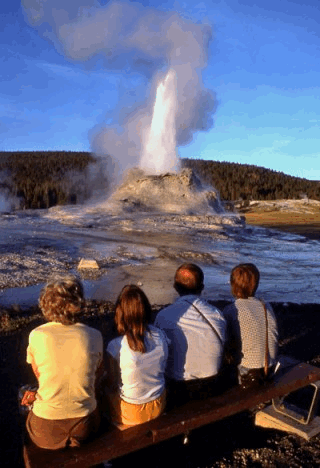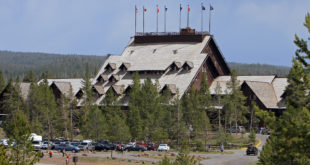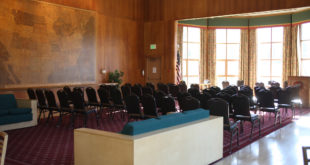Summer
 Most visitors to Yellowstone National Park will have their first exposure to the Park in the summertime.
Most visitors to Yellowstone National Park will have their first exposure to the Park in the summertime.
For most, Yellowstone National Park will be a welcome respite from the hot temperatures back home. In terms of climate, Yellowstone doesn’t get very hot in summer. Temperatures rarely go above 85ºF, technically speaking. But a temperature must lower — like 68ºF or so — could fool most people. Standing in the middle of a geyser basin on a windless sunny day, or near the Gardner River in the sagebrush flats at Mammoth, it feels hot –- and is hot, maybe as much as 100ºF (38ºC), if only because of reflected sunlight. The difference in temperature between sunlit and shady areas is dramatic and is enhanced by the often extreme dryness of the air. During the summer relative humidity can drop below 20% during the day, which means that standing in the shade with a breeze can actually feel chilly, even when it’s hot. In short, summer conditions in many parts of Yellowstone are almost desert-like, with bright warm days and suddenly chilly nights. Because of the high altitude and relative lack of air pollution, the sun is extremely bright, often surprising people with how quickly they can acquire nice sunburn or raw overexposed eyes.
Although it varies somewhat by location, summer in Yellowstone begins in late June and ends in early September, not unlike most areas in the northern United States. It’s the time when insects are the most abundant, especially mosquitoes in early July. It’s also the time when the majority of visitors arrive, about 2.5 million people packed into July and August. As the people arrive, the ground dries, and the animals vacate the valleys for high pasture or go deeper into the forests.
Throughout the summer, thunderstorms will rumble across the area. They’re usually not like the massive storms of the Midwest; tornadoes are extremely rare in and around the park; but they can pack a windy punch. There are also many storms that have little or no rain, despite their threatening appearance. These are the ones that blow up winds that fan forest fires. Fire season comes with summer, sometimes as early as the end of June, more often in July. As the forest dries out from spring snow and rain, the ground cover becomes tinder. Especially in drought years, the trees themselves dry out, sometimes with water content less than 15%. Lightning starts many fires. By mid to late summer, it is not uncommon to see smoke clouds all over Yellowstone and to smell the acrid but faintly sweet pine smoke.
Fall
 Autumn is slightly peculiar in Yellowstone. It can be surprisingly short, beginning in the middle of September and completely over by mid-October. Some years it stretches from early September to mid-November. It is often dry, though punctuated by occasional periods of gray-day light rain or early snowfalls. Because there are so few deciduous trees, the changing color of leaves is mostly conspicuous by its absence. Day temperatures can often be summer-like, from 60ºF to 75ºF (16ºC-23ºC), but frost comes almost any night. It’s not the time for growing things; between the cold and the dryness, most everything turns gold, brown, or olive green, but it is the amber time of year, often accompanied by the faint glow of slightly smoky air and the sun’s rays coming at a lower angle. The flip side of the lack of growing things is the lack of insects, especially mosquitoes; even most of the flies are gone. In late fall, usually November, the animals begin to return from their high mountain retreats and the valleys begin to fill with the herds of elk, bison, and deer.
Autumn is slightly peculiar in Yellowstone. It can be surprisingly short, beginning in the middle of September and completely over by mid-October. Some years it stretches from early September to mid-November. It is often dry, though punctuated by occasional periods of gray-day light rain or early snowfalls. Because there are so few deciduous trees, the changing color of leaves is mostly conspicuous by its absence. Day temperatures can often be summer-like, from 60ºF to 75ºF (16ºC-23ºC), but frost comes almost any night. It’s not the time for growing things; between the cold and the dryness, most everything turns gold, brown, or olive green, but it is the amber time of year, often accompanied by the faint glow of slightly smoky air and the sun’s rays coming at a lower angle. The flip side of the lack of growing things is the lack of insects, especially mosquitoes; even most of the flies are gone. In late fall, usually November, the animals begin to return from their high mountain retreats and the valleys begin to fill with the herds of elk, bison, and deer.
Winter
 “How do these animals survive?” asked one of the animal spotters. It was early November, with first permanent snow already on the ground and it was at least -10ºF (-23ºC) in the Lamar Valley that morning. The wind clawed at scarves and coats, and froze metal in seconds flat. Out in the valley, pawing the crusted ground for food were several thousand elk and bison; and it was only November with almost six more months of winter yet to come. Winter is just one of the seasons in Yellowstone, but it’s the big one, the one that dominates all life -– even humans.
“How do these animals survive?” asked one of the animal spotters. It was early November, with first permanent snow already on the ground and it was at least -10ºF (-23ºC) in the Lamar Valley that morning. The wind clawed at scarves and coats, and froze metal in seconds flat. Out in the valley, pawing the crusted ground for food were several thousand elk and bison; and it was only November with almost six more months of winter yet to come. Winter is just one of the seasons in Yellowstone, but it’s the big one, the one that dominates all life -– even humans.
Because of its altitude, on average nearly 7,500 ft (2300 m) above sea level, Yellowstone has long, cold winters. Temperatures can drop below -40ºF (-40ºC) and several feet of snowfall is common throughout the park. First snow usually comes in September, although it doesn’t remain in the valleys until sometime in October. Last snow leaves the valleys in April and May, but not until June in the higher elevations. Snow dictates when the park roads close in the fall and re-open in the spring. Only one road is kept open all year, between Gardiner, Montana and Mammoth Hot Springs, the park headquarters, and then on to the tiny mountain communities of Cooke City and Silver Gate, Montana. Fortunately, much of this road is in the warmest and driest areas of the park, but it’s still expensive to plow. The rest of the park roads are buried by heavy snowfall and blizzard borne drifts; they’re much too expensive to keep open. In fact, it’s a big job just to re-open the roads in spring; it takes nearly a month of plowing from mid-April to mid-May.
Meanwhile, during the long period of winter, the bigger animals live off their stored fat. Some animals such as predators live from animals weakened by the winter, or sleep like the lucky bears. Most birds migrate to warmth; a few like the resourceful ravens follow the predators for scraps of the kill, or like some small birds, live from seeds and insects in the forest. Survival is paramount and not easy. In winter, illness or injury is almost invariably fatal. Often, just when the winter seems broken, when the first green is poking out between the melting drifts, fierce spring storms sweep the Yellowstone country dumping heavy snow and plunging temperatures back far below freezing. Winter kill is a fact of life in Yellowstone; it has a big role in determining the population of birds, animals, and fish.
A few thousand human beings visit Yellowstone in winter each year. They can celebrate the unbroken silence, the shadowy white purity of snow covered vistas, and the sky-reaching plumes of vapor that envelope the geyser basins. On a blue-sky day, windless and cold, the towers of steam erected by the great geysers are like nothing else on earth.
Spring
 Spring is a motley coat in Yellowstone. It comes early to the lower regions of the park around Mammoth Hot Springs, sometimes in March. It can arrive in July for Dunraven Pass on Mount Washburn and in the surrounding mountain ranges of the Absarokas, Beartooth, and Gallatin. True spring arrives when the grass turns rich emerald green. There are so few leafy trees in the park, a few stands of aspen mostly in the northern range, that they’re hardly the measure of spring’s progress. True spring is also marked by the roar of rivers, streams, and creeks –- filled to their banks with runoff from melting snow. Waterfalls, of which there are more than three hundred in Yellowstone, are at their peak; especially the two giants lodged in the Grand Canyon of the Yellowstone –- the Upper and Lower Falls.
Spring is a motley coat in Yellowstone. It comes early to the lower regions of the park around Mammoth Hot Springs, sometimes in March. It can arrive in July for Dunraven Pass on Mount Washburn and in the surrounding mountain ranges of the Absarokas, Beartooth, and Gallatin. True spring arrives when the grass turns rich emerald green. There are so few leafy trees in the park, a few stands of aspen mostly in the northern range, that they’re hardly the measure of spring’s progress. True spring is also marked by the roar of rivers, streams, and creeks –- filled to their banks with runoff from melting snow. Waterfalls, of which there are more than three hundred in Yellowstone, are at their peak; especially the two giants lodged in the Grand Canyon of the Yellowstone –- the Upper and Lower Falls.
Spring is the wet time of the year all around. Melting snow combines with frequent thunder showers to keep the earth muddy throughout the months of April, May, and into June. As soon as the snow departs and the soil warms just a little, flowers bloom like there is no tomorrow. Some of them can’t wait, and like the glacier lily or white asphodel, poke their colors through the last vestiges of snow. The big valleys –- Lamar, Yellowstone, Madison, Firehole — being somewhat warmer and drier, reach high spring by May, and their rich growth keeps the herds of bison and elk busy eating and tending to their young. Among the grasses and sagebrush grow dozens of varieties of spring flowers, usually in small bunches. Higher, in the more alpine regions of Mt. Washburn and Sylvan Pass, high spring arrives in June and in good years may be accompanied by fields of color as lupine, shooting star, paint brush, and other flowers bloom in profusion.
Temperatures in spring tend to vary wildly, not only from day to day, but from place to place within the park. Mammoth Hot Springs can be downright hot in April, while at the same time, snow showers might be occurring over Sylvan Pass. Yellowstone is big enough to be covered unequally by advancing weather systems, so that one part of the park may be gray and rainy, while another basks in sunlight. In spring thundershowers can pop up anywhere (or nowhere), dropping temperatures sharply as they pass. Occasionally, winter makes a comeback –- anywhere in the park –- well into June.
[Seasons: Storm over Yellowstone Lake, nking; Winter — Wolf Pack on the Move, NPS photo; Spring — Lower Falls in full Flood, nking; Summer — Watching Castle Geyser, kreichard; Fall — One Gold Tree, Lamar Valley, nking] Yellowstone Insider Your Complete Guide to America's First National Park
Yellowstone Insider Your Complete Guide to America's First National Park






